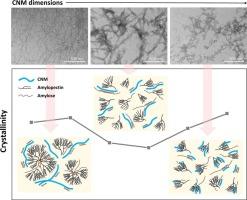纤维素纳米材料尺寸对热塑性淀粉复合材料晶体结构和性能的影响
IF 12.5
1区 化学
Q1 CHEMISTRY, APPLIED
引用次数: 0
摘要
热塑性淀粉(TPS)越来越被认为是制造可持续和可生物降解材料的有前途的候选人。在这项研究中,我们研究了纤维素纳米材料(CNMs)的尺寸在TPS糊化和退化过程中如何影响晶体结构。采用酸水解法制备了不同尺寸的纳米纤维素。x射线衍射和差示扫描量热分析证实,CNM尺寸的减小促进了聚集的支链淀粉(AP)簇的破坏,导致长直链淀粉(AM)链的释放和结晶成vh型结构。相比之下,较大的cnm保留了AP簇,有利于形成b型双螺旋。这种与尺寸相关的晶体结构转变显著影响了TPS复合材料的力学性能。与纯TPS相比,韧性提高了34%,特别是中间cnm(平均长度~ 233 nm),促进了强度和伸长率之间的良好平衡。此外,CNM的加入均匀地降低了约20%的水吸附,而氧渗透率随着CNM尺寸的减小而从1.61 cm3·mm·m−2·day−1·atm−1下降到0.52 cm3·mm·m−2。这些发现表明,CNM尺寸可以为TPS复合材料的不同应用提供量身定制的晶体结构开发和性能优化。本文章由计算机程序翻译,如有差异,请以英文原文为准。

Influence of cellulose nanomaterial dimensions on the crystalline structure and properties of thermoplastic starch composites
Thermoplastic starch (TPS) is increasingly recognized as a promising candidate for the manufacture of sustainable and biodegradable materials. In this study, we investigate how the dimensions of cellulose nanomaterials (CNMs) influence crystalline structures during the gelatinization and retrogradation of TPS. CNMs with systematically varied dimensions were prepared via acid hydrolysis of cellulose nanofibrils. X-ray diffraction and differential scanning calorimetry analyses confirmed that decreasing CNM dimensions promoted the disruption of aggregated amylopectin (AP) clusters, leading to the release and crystallization of long amylose (AM) chains into Vh-type structures. In contrast, larger CNMs preserved the AP clusters, favoring the formation of B-type double helices. This dimension-dependent transition of crystalline structures significantly influenced the mechanical properties of TPS composites. Toughness improved by up to 34 % compared to neat TPS, particularly with intermediate CNMs (average length ∼ 233 nm), promoting a favorable balance between strength and elongation. Furthermore, CNM incorporation uniformly reduced water adsorption by approximately 20 %, while oxygen permeability decreased from 1.61 to 0.52 cm3·mm·m−2·day−1·atm−1 with decreasing CNM dimensions. These findings demonstrate that CNM dimensions enable tailored crystalline structure development and property optimization in TPS composites for diverse applications.
求助全文
通过发布文献求助,成功后即可免费获取论文全文。
去求助
来源期刊

Carbohydrate Polymers
化学-高分子科学
CiteScore
22.40
自引率
8.00%
发文量
1286
审稿时长
47 days
期刊介绍:
Carbohydrate Polymers stands as a prominent journal in the glycoscience field, dedicated to exploring and harnessing the potential of polysaccharides with applications spanning bioenergy, bioplastics, biomaterials, biorefining, chemistry, drug delivery, food, health, nanotechnology, packaging, paper, pharmaceuticals, medicine, oil recovery, textiles, tissue engineering, wood, and various aspects of glycoscience.
The journal emphasizes the central role of well-characterized carbohydrate polymers, highlighting their significance as the primary focus rather than a peripheral topic. Each paper must prominently feature at least one named carbohydrate polymer, evident in both citation and title, with a commitment to innovative research that advances scientific knowledge.
 求助内容:
求助内容: 应助结果提醒方式:
应助结果提醒方式:


